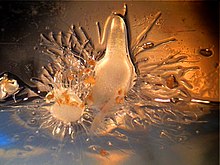Orchid mycorrhiza
Orchid mycorrhizae are endomycorrhizal fungi which develop symbiotic relationships with the roots and seeds of plants of the family Orchidaceae.
[8] Orchids lacking chlorophyll, called achlorophyllous mycoheterotrophs, will retain their fungal symbionts their entire lives, relying on the fungus for carbon.
Fungal hyphae can penetrate the parenchyma cells of germinated orchid seeds, protocorms, late-staged seedlings, or adult plant roots.
[4] The formation of pelotons in root cortical cells is a defining anatomical structure in orchid mycorrhiza that differentiate it from other forms of fungi.
[21] As pelotons of live fungal hyphae age and are eventually disintegrated, or lysed, they appear as brown or yellow clumps in the orchid cells.
[22][23] Some of the challenges in determining host-specificity in orchid mycorrhizae have been the methods of identifying the orchid-specific fungi from other free living fungal species in wild-sourced samples.
Even with modern molecular analysis and genomic databases, this can still prove difficult,[24] partially due to the difficulty in culturing fungi from protocorms and identification of fungal samples,[24] as well as changes in evolving rDNA.
[26] The types of orchids and their symbiotic fungi also vary depending on the environmental niches they occupy, whether terrestrial or growing on other plants as an epiphyte.
[28] Orchid mycorrhizal associations involve a plethora of distinctive nutrient transport systems, structures and phenomena which have only been observed in the family Orchidaceae.
[33] It has been indicated in past studies that orchid plant individuals which inhabit dense highly shaded forests may depend significantly more on their fungal partner for carbon, varying within and between species, demonstrating the variable and reactive nature of these interaction.
Nutrient transfer mechanisms and the symbiotic mycorrhizal peloton organs start to appear only shortly after infection around 20–36 hours after initial contact.
[28] There is significant genetic upregulation and downregulation of many different genes to facilitate the creation of the symbiotic organ, and the pathways with which nutrients travel.
As the fungus enters the parenchyma cells of the orchid the plasma membrane invaginates to facilitate fungal infection and growth.
[36] This newly invaginated plasma membrane surrounds the growing pelotons and creates a huge surface area from which nutrients can be exchanged.
[37][28][38] The surrounding plant membrane essentially becomes rough endoplasmic reticulum with high amounts of ribosomes and a plethora of transporter proteins, and aquaporins.
[31] This highly convoluted and transporter rich membrane expertly performs the duties of nutrient exchange between the plant and fungus and allows for molecular manipulation by ribosomes and excreted enzymes within the interfacial apoplast.
This happens in all endomycorrhizal associations but orchid plants readily digest fungal pelotons sooner after formation and more often than is seen in arbuscular mycorrhizal interactions.
Mycorrhizal fungi are extremely efficient at doing this due to their extensive soil surface area as well as high enzymatic diversity.
Bioavailable nitrogen as nitrate and ammonium are absorbed from the soil media into the extraradical mycelium of the mycorrhizal fungi and assimilated into amino acids.
[28][42][41] Orchid mycorrhizal interactions encompass a large variety of symbiotic scenarios, ranging from fully mycoheterotrophic plants or in other words parasitic on their fungal inhabitant such as Monotropa uniflora which lacks chlorophyll, to interactions that take on a similar nature to those found in arbuscular mycorrhiza, where in bidirectional nutrient transport takes place such as in green leaved Goodyera repens.
[47][32][33] For the documented interactions in orchid mycorrhiza it has been observed that even in photosynthetically capable species carbon will readily flow from fungi to the plant.
[28] In the mycoheterotrophic orchid mycorrhiza carbon is taken up, by the fungi, as an array of peptide and carbohydrate species often the products of saprophytic reactions taking place in the soil.
[28][49][50] These reactions are often instigated and progressed by the activity of the mycorrhizal fungus, being part of the basidiomycete phyla, orchid associated fungi have an extensive metabolic arsenal with which to pull from, and are readily able to digest cellulose and lignin to obtain the carbon.
[50] Genes encoding proteases, cellulose and lignin digestive enzymes, as well as oligopeptide and carbohydrate transporters are upregulated in the mycelial soil webs to facilitate increased carbon uptake.
[28] As mentioned above as pelotons are formed they are covered by a plant derived membrane, which eventually takes on the properties of endoplasmic reticulum surrounded by Golgi apparatuses.
[50] A siderophore is a small molecule which has extremely high affinity for Fe3+ and is commonly found being utilized by many bacteria and fungal species.
[55] Other vital nutrients may be transferred between mycorrhizal fungi and orchid plants via specialized methods, such as chelating molecules, but more research on this subject is needed.
[28] Current molecular analysis has allowed for the identification of specific taxa forming symbiotic relationships which are of interest in the study, cultivation, and conservation of orchids.
These fungal symbioses, as well as their affinity towards specific symbionts, vary based on the stage of development and age of the host roots.
Mixotrophic orchids like Cephalanthera longibracteata may associate generally with several fungi, most notably from Russulaceae, Tricholomataceae, Sebacinales, Thelephoraceae,[63] as they do not depend as heavily on the fungus for carbon.

